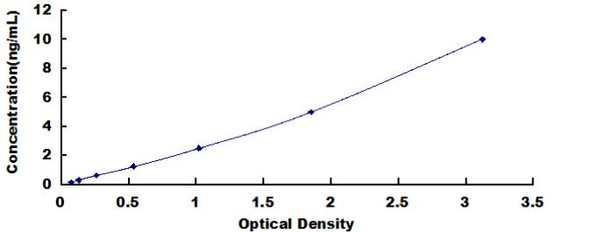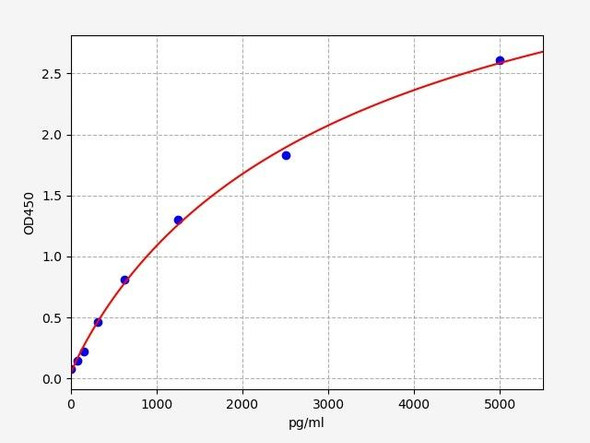Human Cell Biology ELISA Kits 4
Human GL alpha (Galactosidase Alpha) CLIA Kit (HUES00578)
- SKU:
- HUES00578
- Product Type:
- ELISA Kit
- ELISA Type:
- CLIA Kit
- Size:
- 96 Assays
- Sensitivity:
- 9.38pg/mL
- Range:
- 15.63-1000pg/mL
- ELISA Type:
- Sandwich
- Reactivity:
- Human
- Sample Type:
- Serum, plasma and other biological fluids
- Research Area:
- Cell Biology
Description
| Assay type: | Sandwich |
| Format: | 96T |
| Assay time: | 4.5h |
| Reactivity: | Human |
| Detection method: | Chemiluminescence |
| Detection range: | 15.63-1000 pg/mL |
| Sensitivity: | 9.38 pg/mL |
| Sample volume: | 100µL |
| Sample type: | Serum, plasma and other biological fluids |
| Repeatability: | CV < 15% |
| Specificity: | This kit recognizes Human GL alpha in samples. No significant cross-reactivity or interference between Human GL alpha and analogues was observed. |
This kit uses Sandwich-CLIA as the method. The micro CLIA plate provided in this kit has been pre-coated with an antibody specific to Human GL alpha. Standards or samples are added to the appropriate micro CLIA plate wells and combined with the specific antibody. Then a biotinylated detection antibody specific for Human GL alpha and Avidin-Horseradish Peroxidase (HRP) conjugate are added to each micro plate well successively and incubated. Free components are washed away. The substrate solution is added to each well. Only those wells that contain Human GL alpha, biotinylated detection antibody and Avidin-HRP conjugate will appear fluorescence. The Relative light unit (RLU) value is measured spectrophotometrically by the Chemiluminescence immunoassay analyzer. The RLU value is positively associated with the concentration of Human GL alpha. The concentration of Human GL alpha in the samples can be calculated by comparing the RLU of the samples to the standard curve.
| UniProt Protein Function: | GLA: Defects in GLA are the cause of Fabry disease (FD). FD is a rare X-linked sphingolipidosis disease where glycolipid accumulates in many tissues. The disease consists of an inborn error of glycosphingolipid catabolism. FD patients show systemic accumulation of globotriaoslyceramide (Gb3) and related glycosphingolipids in the plasma and cellular lysosomes throughout the body. Clinical recognition in males results from characteristic skin lesions (angiokeratomas) over the lower trunk. Patients may show ocular deposits, febrile episodes, and burning pain in the extremities. Death results from renal failure, cardiac or cerebral complications of hypertension or other vascular disease. Heterozygous females may exhibit the disorder in an attenuated form, they are more likely to show corneal opacities. Belongs to the glycosyl hydrolase 27 family. |
| UniProt Protein Details: | Protein type:Lipid Metabolism - sphingolipid; Lipid Metabolism - glycerolipid; EC 3. 2. 1. 22; Glycan Metabolism - glycosphingolipid biosynthesis - globo series; Hydrolase; Carbohydrate Metabolism - galactose Chromosomal Location of Human Ortholog: Xq22 Cellular Component: cytoplasm; extracellular region; Golgi apparatus; lysosomal lumen; lysosome Molecular Function:alpha-galactosidase activity; catalytic activity; hydrolase activity; protein binding; protein homodimerization activity; receptor binding Biological Process: glycosphingolipid catabolic process; glycosphingolipid metabolic process; glycosylceramide catabolic process; negative regulation of nitric oxide biosynthetic process; negative regulation of nitric-oxide synthase activity; oligosaccharide metabolic process Disease: Fabry Disease |
| NCBI Summary: | This gene encodes a homodimeric glycoprotein that hydrolyses the terminal alpha-galactosyl moieties from glycolipids and glycoproteins. This enzyme predominantly hydrolyzes ceramide trihexoside, and it can catalyze the hydrolysis of melibiose into galactose and glucose. A variety of mutations in this gene affect the synthesis, processing, and stability of this enzyme, which causes Fabry disease, a rare lysosomal storage disorder that results from a failure to catabolize alpha-D-galactosyl glycolipid moieties. [provided by RefSeq, Jul 2008] |
| UniProt Code: | P06280 |
| NCBI GenInfo Identifier: | 113499 |
| NCBI Gene ID: | 2717 |
| NCBI Accession: | P06280. 1 |
| UniProt Secondary Accession: | P06280,Q6LER7, |
| UniProt Related Accession: | P06280 |
| Molecular Weight: | 48,767 Da |
| NCBI Full Name: | Alpha-galactosidase A |
| NCBI Synonym Full Names: | galactosidase alpha |
| NCBI Official Symbol: | GLA |
| NCBI Official Synonym Symbols: | GALA |
| NCBI Protein Information: | alpha-galactosidase A |
| UniProt Protein Name: | Alpha-galactosidase A |
| UniProt Synonym Protein Names: | Alpha-D-galactosidase A; Alpha-D-galactoside galactohydrolase; Melibiase; INN: Agalsidase |
| Protein Family: | Glacontryphan |
| UniProt Gene Name: | GLA |
| UniProt Entry Name: | AGAL_HUMAN |
As the RLU values of the standard curve may vary according to the conditions of the actual assay performance (e. g. operator, pipetting technique, washing technique or temperature effects), the operator should establish a standard curve for each test. Typical standard curve and data is provided below for reference only.
| Concentration (pg/mL) | RLU | Average | Corrected |
| 1000 | 50164 57186 | 53675 | 53650 |
| 500 | 20530 24448 | 22489 | 22464 |
| 250 | 10928 9494 | 10211 | 10186 |
| 125 | 4557 5245 | 4901 | 4876 |
| 62.5 | 2592 2314 | 2453 | 2428 |
| 31.25 | 1317 1245 | 1281 | 1256 |
| 15.63 | 686 730 | 708 | 683 |
| 0 | 25 25 | 25 | -- |
Precision
Intra-assay Precision (Precision within an assay): 3 samples with low, mid range and high level Human GL alpha were tested 20 times on one plate, respectively.
Inter-assay Precision (Precision between assays): 3 samples with low, mid range and high level Human GL alpha were tested on 3 different plates, 20 replicates in each plate.
| Intra-assay Precision | Inter-assay Precision | |||||
| Sample | 1 | 2 | 3 | 1 | 2 | 3 |
| n | 20 | 20 | 20 | 20 | 20 | 20 |
| Mean (pg/mL) | 52.48 | 111.55 | 336.34 | 50.91 | 117.29 | 331.85 |
| Standard deviation | 6.57 | 13.02 | 22.10 | 5.03 | 12.17 | 35.64 |
| C V (%) | 12.52 | 11.67 | 6.57 | 9.88 | 10.38 | 10.74 |
Recovery
The recovery of Human GL alpha spiked at three different levels in samples throughout the range of the assay was evaluated in various matrices.
| Sample Type | Range (%) | Average Recovery (%) |
| Serum (n=5) | 96-114 | 104 |
| EDTA plasma (n=5) | 90-100 | 95 |
| Cell culture media (n=5) | 88-104 | 95 |
Linearity
Samples were spiked with high concentrations of Human GL alpha and diluted with Reference Standard & Sample Diluent to produce samples with values within the range of the assay.
| Serum (n=5) | EDTA plasma (n=5) | Cell culture media (n=5) | ||
| 1:2 | Range (%) | 84-97 | 100-114 | 91-103 |
| Average (%) | 91 | 106 | 97 | |
| 1:4 | Range (%) | 96-112 | 98-115 | 99-116 |
| Average (%) | 102 | 105 | 107 | |
| 1:8 | Range (%) | 94-107 | 87-100 | 89-101 |
| Average (%) | 101 | 93 | 95 | |
| 1:16 | Range (%) | 97-111 | 103-119 | 87-101 |
| Average (%) | 102 | 109 | 94 |
An unopened kit can be stored at 4°C for 1 month. If the kit is not used within 1 month, store the items separately according to the following conditions once the kit is received.
| Item | Specifications | Storage |
| Micro CLIA Plate(Dismountable) | 8 wells ×12 strips | -20°C, 6 months |
| Reference Standard | 2 vials | |
| Concentrated Biotinylated Detection Ab (100×) | 1 vial, 120 µL | |
| Concentrated HRP Conjugate (100×) | 1 vial, 120 µL | -20°C(shading light), 6 months |
| Reference Standard & Sample Diluent | 1 vial, 20 mL | 4°C, 6 months |
| Biotinylated Detection Ab Diluent | 1 vial, 14 mL | |
| HRP Conjugate Diluent | 1 vial, 14 mL | |
| Concentrated Wash Buffer (25×) | 1 vial, 30 mL | |
| Substrate Reagent A | 1 vial, 5 mL | 4°C (shading light) |
| Substrate Reagent B | 1 vial, 5 mL | 4°C (shading light) |
| Plate Sealer | 5 pieces | |
| Product Description | 1 copy | |
| Certificate of Analysis | 1 copy |
- Set standard, test sample and control (zero) wells on the pre-coated plate and record theirpositions. It is recommended to measure each standard and sample in duplicate. Note: addall solutions to the bottom of the plate wells while avoiding contact with the well walls. Ensuresolutions do not foam when adding to the wells.
- Aliquot 100µl of standard solutions into the standard wells.
- Add 100µl of Sample / Standard dilution buffer into the control (zero) well.
- Add 100µl of properly diluted sample (serum, plasma, tissue homogenates and otherbiological fluids. ) into test sample wells.
- Cover the plate with the sealer provided in the kit and incubate for 90 min at 37°C.
- Aspirate the liquid from each well, do not wash. Immediately add 100µL of BiotinylatedDetection Ab working solution to each well. Cover the plate with a plate seal and gently mix. Incubate for 1 hour at 37°C.
- Aspirate or decant the solution from the plate and add 350µL of wash buffer to each welland incubate for 1-2 minutes at room temperature. Aspirate the solution from each well andclap the plate on absorbent filter paper to dry. Repeat this process 3 times. Note: a microplatewasher can be used in this step and other wash steps.
- Add 100µL of HRP Conjugate working solution to each well. Cover with a plate seal andincubate for 30 min at 37°C.
- Aspirate or decant the solution from each well. Repeat the wash process for five times asconducted in step 7.
- Add 100µL of Substrate mixture solution to each well. Cover with a new plate seal andincubate for no more than 5 min at 37°C. Protect the plate from light.
- Determine the RLU value of each well immediately.






